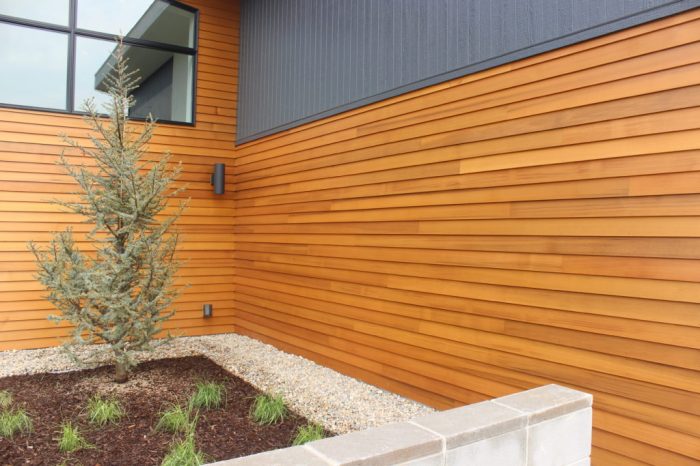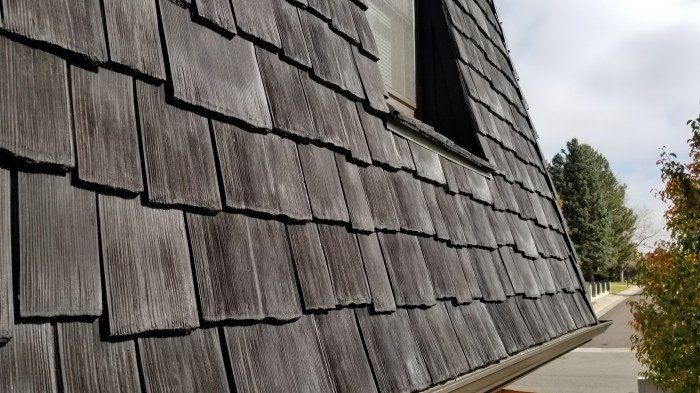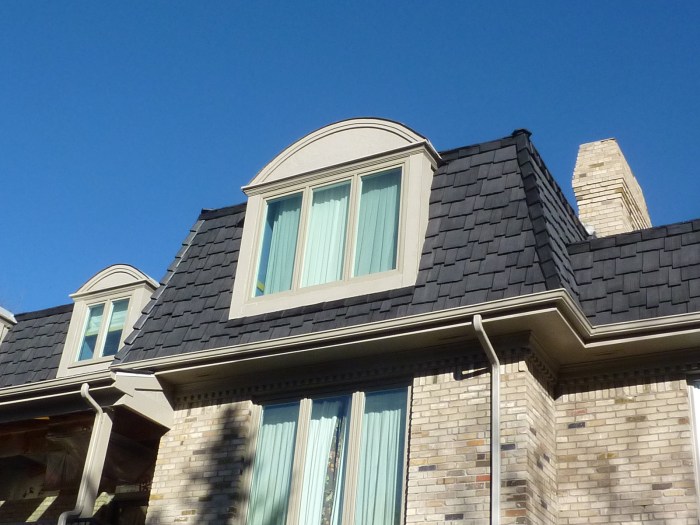Faux Cedar Siding A Complete Guide
Faux cedar siding offers a compelling alternative to real cedar, blending aesthetic appeal with practicality. This comprehensive guide delves into the material composition, manufacturing processes, installation techniques, and long-term cost-effectiveness of faux cedar siding, comparing it directly to its natural counterpart. We’ll explore the various types available, from vinyl and fiber cement to PVC, examining their unique properties and visual characteristics. Understanding the pros and cons, both aesthetically and environmentally, is key to making an informed decision for your next home improvement project.
We’ll cover everything from choosing the right color and texture to mastering the installation process and maintaining your faux cedar siding for years to come. By the end, you’ll have the knowledge to confidently select and install the perfect faux cedar siding to enhance your home’s curb appeal and protect your investment.
Faux Cedar Siding

Faux cedar siding offers a compelling alternative to natural cedar, mirroring its aesthetic appeal while potentially offering advantages in cost, maintenance, and longevity. Understanding its composition, manufacturing process, and environmental impact is crucial for informed decision-making.
Material Composition and Manufacturing Processes
Faux cedar siding utilizes a variety of materials, each impacting its final properties and cost. Common materials include vinyl, PVC (polyvinyl chloride), and fiber cement. The manufacturing process generally involves several key steps, regardless of the primary material. First, raw materials are processed and mixed. For vinyl siding, this involves melting and blending PVC resin with various additives for color, UV resistance, and impact strength. Fiber cement involves mixing cement, cellulose fibers, and other additives. Next, the mixture is shaped, typically through extrusion for vinyl and PVC, and molding or casting for fiber cement. This process creates long lengths of siding that are then cut to size. Finally, the siding undergoes a finishing process which may include painting, texturing, and quality control checks to ensure consistent appearance and durability.
Comparison of Faux Cedar Siding Types
Vinyl siding is known for its affordability and low maintenance. It’s lightweight, easy to install, and comes in a wide range of colors and textures designed to mimic the look of cedar. However, it can be less durable than other options and may fade or warp over time, especially under intense sunlight. PVC siding shares similar advantages to vinyl, offering excellent water resistance and a relatively long lifespan. Fiber cement siding, on the other hand, boasts superior durability and fire resistance. It’s heavier and more difficult to install than vinyl or PVC, but its strength and longevity make it a premium option. The realistic wood grain texture of fiber cement siding often surpasses that of vinyl or PVC.
Environmental Impact Compared to Real Cedar
The environmental impact of faux cedar siding versus real cedar is a complex issue. Real cedar harvesting contributes to deforestation and habitat loss, especially if sourced unsustainably. Transportation of real cedar also has a carbon footprint. The manufacturing of faux cedar siding, however, involves energy consumption and the production of waste materials. The environmental impact varies depending on the specific material and manufacturing processes. For instance, vinyl and PVC production relies heavily on fossil fuels, leading to significant greenhouse gas emissions. Fiber cement, while potentially more environmentally friendly due to the use of readily available materials, still involves energy-intensive manufacturing processes. A life-cycle assessment comparing the total environmental impact of each option, considering manufacturing, transportation, lifespan, and eventual disposal, is necessary for a complete comparison. This requires considering factors like energy usage, water consumption, and waste generation throughout the product’s lifecycle. Ultimately, the “greener” option depends on several factors, including the sourcing and manufacturing processes of both real and faux cedar, as well as the longevity of each product.
Faux Cedar Siding

Faux cedar siding offers a compelling alternative to natural cedar, balancing aesthetic appeal with practicality and cost-effectiveness. This durable and low-maintenance option provides homeowners with a visually pleasing exterior that mimics the beauty of real cedar without the associated upkeep and potential vulnerabilities. Let’s delve into the visual aspects of this popular siding choice.
Faux Cedar Siding Appearance and Aesthetics
Faux cedar siding boasts a remarkable range of colors and textures designed to replicate the natural variation found in genuine cedar. Manufacturers achieve this through innovative production processes, employing various materials and techniques to create realistic-looking planks. The result is a diverse selection that caters to a wide spectrum of architectural styles and personal preferences.
Different manufacturers offer a variety of colors, ranging from traditional reddish-brown tones to more contemporary grays and even muted greens. These colors are often achieved through the use of pigments added during the manufacturing process, resulting in consistent and long-lasting hues. The textures also vary significantly. Some faux cedar siding options mimic the deeply grooved profile of natural cedar, while others offer a smoother, more refined finish. This textural diversity allows homeowners to choose a product that best suits their desired aesthetic.
The appearance of faux cedar siding, unlike its natural counterpart, changes relatively little over time due to weathering. While some subtle fading might occur with prolonged sun exposure, the color and texture remain remarkably consistent. This is a significant advantage over real cedar, which requires regular maintenance, including staining or sealing, to protect it from the elements and maintain its visual appeal. The color might shift slightly towards a more muted tone after several years of exposure to the elements, but this subtle change often adds to the overall charm of the siding. This predictable aging process contrasts sharply with the unpredictable and sometimes uneven weathering of natural cedar.
Compared to real cedar siding, faux cedar offers several aesthetic advantages. Its consistent color and texture provide a more uniform look, eliminating the variations in grain and color that are inherent in natural wood. This uniformity can be particularly appealing for modern architectural styles. However, some homeowners prefer the natural imperfections and unique character of real cedar. While faux cedar strives for realism, it can sometimes lack the subtle nuances and organic feel of natural wood. This is a matter of personal preference, with both materials offering distinct aesthetic appeals. The cost-effectiveness of faux cedar is another key advantage, as it is typically less expensive than real cedar, making it a more accessible option for many homeowners.
| Color | Texture | Realistic Appearance | Price Point |
|---|---|---|---|
| Reddish-Brown | Deeply Grooved | High | Mid-range |
| Gray | Smooth | Medium | Lower |
| Weathered Gray | Medium Grooved | High | Mid-range |
| Taupe | Slightly Grooved | Medium | Lower |
Faux Cedar Siding Installation and Maintenance
Faux cedar siding offers a beautiful, low-maintenance alternative to real cedar. Its realistic appearance and durability make it a popular choice for homeowners seeking a cost-effective and visually appealing exterior. Understanding the installation process and proper maintenance techniques is crucial for maximizing the lifespan and aesthetic appeal of your faux cedar siding.
Faux Cedar Siding Installation: A Step-by-Step Guide
Proper installation is key to ensuring a long-lasting and attractive finish. This involves careful planning, the right tools, and adherence to safety guidelines. Begin by carefully measuring and planning the layout of your siding to minimize waste and ensure a professional look.
- Preparation: Start by cleaning the existing wall surface, removing any loose debris, old siding, or damaged areas. Ensure the surface is level and free from any obstructions. Consider using a pressure washer for thorough cleaning.
- Framing (if necessary): If installing over existing siding, ensure the underlying structure is sound and properly braced. For new construction, install appropriate framing to provide a solid base for the siding.
- Installation of Starter Strip: Begin by installing a starter strip along the bottom of the wall, ensuring it’s level and plumb. This provides a consistent starting point for the remaining siding panels.
- Siding Panel Installation: Install the siding panels, overlapping each panel according to the manufacturer’s instructions. Use appropriate fasteners, ensuring they are driven straight and flush to avoid damage to the siding.
- Finishing: Install corner trim, J-channel, and other necessary finishing pieces to complete the installation. Ensure all seams are properly sealed to prevent water intrusion.
Fastening Methods for Faux Cedar Siding
Several methods exist for securing faux cedar siding, each with its own advantages and disadvantages. The choice depends on factors such as the type of siding, wall material, and climate.
- Nails: Galvanized nails are commonly used, ensuring corrosion resistance. The nail size and placement should follow the manufacturer’s recommendations to avoid splitting the siding.
- Staples: Staples can be a faster alternative, but require careful placement to avoid damaging the siding. They are often used with a pneumatic stapler.
- Screws: Screws offer greater holding power and can be easily removed if adjustments are needed. However, they require precise placement to avoid visible screw heads.
Faux Cedar Siding Maintenance
Regular maintenance will prolong the life and beauty of your faux cedar siding. This primarily involves cleaning and occasional repairs.
Cleaning should be done annually, or more frequently if necessary, using a mild detergent and a soft-bristled brush or pressure washer (low pressure setting). Avoid abrasive cleaners or harsh chemicals that could damage the siding’s finish. For stubborn stains, a specialized siding cleaner may be necessary. Repairing damaged panels typically involves replacing the affected section with a new panel, matching the color and texture as closely as possible. Minor scratches or scuffs can often be touched up with a suitable paint or stain.
Faux Cedar Siding vs. Real Cedar: Installation and Maintenance Comparison
Faux cedar siding offers significant advantages over real cedar in terms of installation and maintenance. Real cedar requires more frequent maintenance, including staining and sealing to protect against rot, insects, and the elements. It’s also susceptible to warping and cracking over time. Faux cedar, on the other hand, is much more resistant to these issues, requiring minimal maintenance and offering a longer lifespan with less upkeep. The installation of real cedar is also generally more labor-intensive and requires specialized skills, compared to the relative ease of installing faux cedar siding. The lower cost of materials and installation also contributes to the overall cost-effectiveness of faux cedar.
Faux Cedar Siding
Faux cedar siding offers a compelling alternative to natural cedar, balancing aesthetic appeal with practical considerations. Understanding its cost and durability is crucial for homeowners considering this option for their exterior. This section will delve into the factors influencing the price, compare its longevity to real cedar, and explore potential issues.
Cost Factors Influencing Faux Cedar Siding
Several factors significantly impact the overall cost of faux cedar siding. Material type plays a crucial role; vinyl siding, for instance, tends to be less expensive than fiber cement or engineered wood options. The complexity of the installation also affects the final price. A house with intricate architectural details will require more labor, increasing the overall cost. Regional variations in labor rates and material availability also contribute to price fluctuations. Finally, the quality and brand of the siding itself can significantly impact the initial investment. Higher-end products often boast enhanced durability and aesthetic features, justifying a higher price tag. Choosing a reputable installer is vital to avoid costly mistakes and ensure a professional finish.
Faux Cedar Siding Lifespan and Durability Compared to Real Cedar
While both faux and real cedar siding offer attractive aesthetics, their lifespans and durability differ significantly. Real cedar, while beautiful, requires regular maintenance to prevent rot, insect infestation, and weathering. Its lifespan, even with proper maintenance, typically ranges from 15 to 30 years. Faux cedar siding, on the other hand, is engineered for greater resistance to these issues. High-quality vinyl siding, for example, can last 20 to 40 years with minimal maintenance. Fiber cement siding, known for its exceptional durability, boasts an even longer lifespan, often exceeding 50 years. This enhanced longevity translates to lower long-term costs, as repairs and replacements are less frequent.
Potential Problems with Faux Cedar Siding
While durable, faux cedar siding isn’t without potential issues. Vinyl siding, for instance, can fade or become brittle in harsh sunlight, requiring periodic cleaning and potential replacement of damaged sections. Fiber cement siding, while highly durable, can be susceptible to cracking if improperly installed. Improper installation of any type of faux cedar siding can lead to moisture intrusion, causing damage to the underlying structure. Expansion and contraction due to temperature fluctuations can also cause issues, especially if the siding isn’t properly fastened or allowed to expand. Regular inspections and prompt addressing of any problems are key to maintaining the longevity and aesthetic appeal of faux cedar siding.
Cost Comparison: Faux Cedar vs. Real Cedar Siding
The following table provides a comparative analysis of the costs associated with faux cedar and real cedar siding, considering initial investment, maintenance, and lifespan. Note that these figures are estimates and can vary significantly based on location, project complexity, and material choices.
| Feature | Faux Cedar Siding (Vinyl) | Faux Cedar Siding (Fiber Cement) | Real Cedar Siding |
|---|---|---|---|
| Initial Cost (per sq ft) | $4 – $8 | $8 – $15 | $6 – $12 |
| Average Maintenance Cost (per year) | $0 – $100 | $0 – $50 | $100 – $500 |
| Estimated Lifespan (years) | 20-40 | 50+ | 15-30 |
Faux Cedar Siding

Choosing the right siding for your home involves a careful consideration of aesthetics, durability, and environmental impact. While real cedar offers a natural beauty, faux cedar presents a compelling alternative with its own set of environmental advantages and disadvantages. This section delves into the environmental considerations of using faux cedar siding, comparing it to its natural counterpart and examining its overall sustainability.
Environmental Impact of Faux Cedar vs. Real Cedar
The environmental footprint of building materials is a growing concern. Real cedar requires harvesting, transportation, and processing, all of which contribute to carbon emissions and habitat disruption. Deforestation for cedar production can also negatively impact biodiversity and contribute to climate change. In contrast, the manufacturing of faux cedar siding, while involving energy consumption and material production, generally has a lower carbon footprint, depending on the specific material used. The reduced need for harvesting reduces the impact on natural ecosystems. However, the environmental impact of faux cedar varies greatly depending on the materials used and the manufacturing processes employed. For example, vinyl siding, a common type of faux cedar, is derived from petroleum, a non-renewable resource. This contrasts with composite materials that may incorporate recycled content, lessening their environmental burden.
Recyclability and Sustainability of Faux Cedar Siding Materials
The recyclability and sustainability of faux cedar siding materials differ significantly. Vinyl siding, while durable, has historically had low recyclability rates. However, advancements are being made in vinyl recycling technologies. Some manufacturers are exploring options for recycling vinyl siding, and initiatives are underway to improve collection and processing infrastructure. Other faux cedar options, such as fiber cement siding, often incorporate recycled materials in their production and may be more readily recyclable at the end of their lifespan. Furthermore, some composite materials utilize recycled wood fibers, further enhancing their sustainability credentials. The specific recyclability of a given faux cedar product should be verified with the manufacturer.
Energy Efficiency Benefits of Faux Cedar Siding
Faux cedar siding can contribute to improved energy efficiency in homes. Its ability to insulate against heat and cold can reduce energy consumption for heating and cooling. The thermal performance of different faux cedar materials varies; some offer superior insulation properties compared to others. For instance, fiber cement siding, due to its density, can provide better insulation than vinyl siding. The improved energy efficiency translates to lower utility bills and a reduced carbon footprint associated with energy production. The impact on energy efficiency will also depend on factors like the installation method and overall building design.
Pros and Cons of Faux Cedar Siding: Environmental Footprint
Understanding the environmental implications of choosing faux cedar siding requires weighing its pros and cons.
- Pros:
- Reduced deforestation compared to real cedar.
- Potential for incorporating recycled materials in manufacturing (depending on the material).
- Improved energy efficiency leading to lower energy consumption and reduced carbon emissions.
- Longer lifespan than real cedar, reducing the frequency of replacement and associated environmental impact.
- Cons:
- Manufacturing process involves energy consumption and potential emissions.
- Some materials, like vinyl, are derived from non-renewable resources.
- Recyclability rates vary significantly depending on the material and available infrastructure.
- Disposal of old siding can contribute to landfill waste if not properly recycled.
Ultimately, the choice between real and faux cedar siding hinges on a careful weighing of aesthetics, budget, and long-term maintenance considerations. While real cedar offers undeniable natural beauty, faux cedar siding provides a durable, low-maintenance alternative with a comparable aesthetic appeal. This guide has armed you with the knowledge to navigate this decision, enabling you to choose the siding that best suits your individual needs and preferences. Remember to factor in the total cost of ownership, including installation, maintenance, and lifespan, when making your final selection. Your dream home, clad in stunning siding, awaits!
Essential Questionnaire
Can faux cedar siding be painted?
Yes, many types of faux cedar siding can be painted, but it’s crucial to choose a paint specifically designed for the material to ensure proper adhesion and longevity. Always check the manufacturer’s recommendations.
Does faux cedar siding fade in the sun?
While more resistant than real cedar, some fading can occur depending on the material and color. UV-resistant options are available to minimize this effect.
How do I clean faux cedar siding?
Regular cleaning with a mild detergent and water, using a soft brush or sponge, is usually sufficient. Avoid harsh chemicals or pressure washing, which can damage the siding.
Is faux cedar siding fire-resistant?
The fire resistance of faux cedar siding varies depending on the material. Check the manufacturer’s specifications for fire ratings and safety information.
What is the warranty on faux cedar siding?
Warranties vary widely among manufacturers. Always check the specific warranty details before purchasing.









